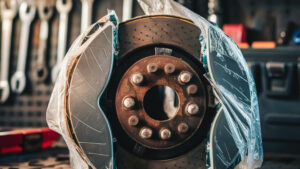To clean a robot vacuum, start by emptying the dustbin and removing any hair or debris from the brushes. Wipe down the sensors and charging contacts with a soft cloth for optimal performance.
Robot vacuums have revolutionized home cleaning by offering convenience and efficiency. However, they require regular maintenance to function effectively. Cleaning your robot vacuum not only enhances its performance but also extends its lifespan. By dedicating a little time to upkeep, you ensure that your vacuum operates at peak efficiency, tackling dust and dirt effortlessly.
This guide will walk you through simple yet effective steps to keep your robot vacuum in top shape. With proper care, your robot vacuum can continue to deliver a spotless home environment without the hassle.
Introduction To Robot Vacuum Maintenance
Keeping your robot vacuum clean is essential. Regular maintenance boosts performance and longevity. A clean robot vacuum will pick up dirt and dust better. This guide helps you understand the basics of robot vacuum maintenance.
The Importance Of Regular Cleaning
Regular cleaning of your robot vacuum ensures it runs smoothly. Here are some key reasons why you should maintain it:
- Improved Performance: A clean vacuum picks up more debris.
- Longer Lifespan: Maintenance prevents wear and tear on parts.
- Better Air Quality: Clean filters reduce dust in your home.
- Cost Savings: Avoids costly repairs or replacements.
Cleaning your robot vacuum is quick and easy. Follow these steps:
- Turn off the vacuum.
- Remove the dustbin and empty it.
- Clean the filter according to the manufacturer’s instructions.
- Check and clean the brushes for hair or debris.
- Wipe down the sensors and charging contacts.
Life Expectancy Of A Well-maintained Robot Vacuum
A well-maintained robot vacuum can last several years. Here’s a breakdown of life expectancy based on care:
| Maintenance Level | Estimated Lifespan |
|---|---|
| Regular Cleaning | 4-6 years |
| Occasional Cleaning | 2-4 years |
| Neglect | 1-2 years |
In summary, regular maintenance is vital. It enhances performance and extends the life of your robot vacuum.
Before You Begin: Pre-cleaning Checklist
Cleaning your robot vacuum helps it work better. Follow this pre-cleaning checklist. It ensures you have everything ready.
Gathering Necessary Supplies
Before starting, gather these supplies:
- Microfiber cloth – For wiping surfaces.
- Soft brush – To remove hair and dust.
- Vacuum cleaner – To clean the dustbin.
- Scissors – For cutting tangled hair.
- Water – For damp cleaning.
Keep these items close. This makes the cleaning process smoother.
Safety Precautions
Safety is important. Follow these precautions:
- Unplug the robot vacuum before cleaning.
- Avoid using water directly on the vacuum.
- Check for any loose parts before starting.
- Be gentle when handling the vacuum’s components.
- Keep small parts away from children and pets.
Taking these steps ensures a safe and effective cleaning process.
Starting With The Basics: External Wipe Down
Cleaning your robot vacuum starts with the external wipe down. Dust and dirt can build up on the exterior. A quick wipe helps maintain its appearance and function. Follow these simple steps to keep your robot vacuum clean.
Choosing The Right Cleaning Cloth
Selecting the right cleaning cloth is essential. Use a microfiber cloth for best results. Microfiber traps dust and grime effectively. Avoid using rough materials that can scratch the surface.
- Microfiber Cloth: Soft and effective.
- Paper Towels: Good for quick clean-ups.
- Cloth Rags: Can be used if clean.
Areas To Focus On
Pay attention to specific areas during the wipe down. These spots collect the most dust and dirt:
- Top Surface: Wipe down the entire top.
- Side Panels: Clean all sides thoroughly.
- Wheels: Remove any hair or debris.
- Charging Contacts: Keep these clean for better charging.
- Dust Bin: Wipe outside and inside.
Regularly cleaning these areas helps your robot vacuum work better. It also extends its lifespan.
Filter Care: Ensuring Optimal Performance
Caring for your robot vacuum’s filter boosts its performance. A clean filter traps dust and allergens effectively. Regular maintenance ensures your vacuum runs at its best.
When To Clean Or Replace
Knowing when to clean or replace your filter is key. Follow these guidelines:
- Check filter after every 3-5 uses.
- Clean filter if it appears dirty or clogged.
- Replace filter every 2-3 months.
- Monitor performance. If suction decreases, clean or replace.
Step-by-step Cleaning Process
Cleaning your robot vacuum’s filter is simple. Follow these easy steps:
- Turn off the vacuum and unplug it.
- Remove the dustbin from the vacuum.
- Take out the filter from the dustbin.
- Tap the filter gently to remove dust.
- Use a soft brush to clean stubborn dirt.
- Rinse the filter under lukewarm water.
- Let the filter dry completely before reinserting.
- Reassemble the dustbin and vacuum.
Remember, a clean filter enhances cleaning efficiency. Regular care prolongs your vacuum’s life.
Brushes And Extractors: Tangle-free Tips
Keeping your robot vacuum’s brushes and extractors clean is vital. Hair and debris can reduce performance. Follow these tips for tangle-free maintenance.
Removing Hair And Debris
Hair and debris often get stuck in brushes. Regular cleaning can help maintain efficiency.
- Check brushes weekly for hair buildup.
- Use scissors to cut hair carefully.
- Pull hair away from the bristles gently.
- Use a cleaning tool or tweezers for small debris.
For stubborn debris, soak brushes in warm soapy water. Rinse and let them dry completely before reattaching.
Maintaining Brush Integrity
Brushes need proper care to last longer. Follow these steps to maintain brush integrity:
- Inspect brushes for wear or damage monthly.
- Replace brushes as needed. Worn brushes can reduce suction.
- Keep extractors free from tangles. This improves overall performance.
- Store your robot vacuum in a clean, dry area.
Use a soft cloth to wipe down the brushes. Avoid harsh chemicals. Regular maintenance keeps your vacuum running smoothly.
Wheels And Sensors: Navigating The Nooks
Keeping your robot vacuum in top shape is essential. The wheels and sensors play a key role in its performance. Regular cleaning ensures smooth navigation and effective cleaning.
Cleaning For Smooth Movement
Dirty wheels can cause your robot vacuum to struggle. Here’s how to clean them:
- Turn off the vacuum and remove it from its dock.
- Inspect the wheels for dirt and debris.
- Use a soft brush to remove hair and dust.
- Wipe the wheels with a damp cloth.
- Check for any damage or wear.
Regular wheel maintenance helps prevent jams. A clean wheel allows for better movement on various surfaces.
Sensor Maintenance For Accurate Navigation
Robot vacuums rely on sensors for navigation. Keeping these sensors clean ensures they work correctly. Follow these steps:
- Locate the sensors on your robot vacuum.
- Use a microfiber cloth to wipe the sensors.
- Check for any obstructions around the sensors.
- Test the vacuum after cleaning to ensure it navigates well.
Dirty sensors can lead to bumps and missed spots. Clean sensors help your vacuum see and avoid obstacles.
Emptying And Cleaning The Dustbin
Cleaning the dustbin of your robot vacuum is essential. A clean dustbin helps your vacuum work better. Regular maintenance keeps your home free from dirt and allergens.
Frequency Of Emptying
Empty the dustbin regularly for optimal performance. Here’s a quick guide:
| Cleaning Frequency | Type of Home |
|---|---|
| Daily | Homes with pets |
| Every 2-3 days | Homes with kids |
| Weekly | Small, clean homes |
Check the dustbin after each cleaning session. This helps avoid clogs.
Deep Cleaning The Dustbin
Deep cleaning ensures the dustbin stays hygienic. Follow these steps:
- Remove the dustbin from your robot vacuum.
- Tap out debris into a trash can.
- Use warm water and mild soap for cleaning.
- Rinse thoroughly to remove soap residue.
- Let it dry completely before reattaching.
Consider cleaning the filter too. A clean filter improves air quality.
Regularly emptying and cleaning the dustbin keeps your robot vacuum efficient. It also extends its lifespan.
Battery Care: Prolonging Robot Vacuum Life
Taking care of your robot vacuum’s battery is crucial. A well-maintained battery extends the vacuum’s lifespan. Follow these tips to ensure your robot vacuum runs smoothly for years.
Best Practices For Charging
- Charge your robot vacuum after every use. This keeps the battery healthy.
- Avoid letting the battery completely drain. This can harm the battery.
- Use the charger that came with your robot vacuum. Third-party chargers may damage it.
- Do not charge in extreme temperatures. Keep it in a cool, dry place.
Signs Of Battery Wear
Recognizing battery wear helps you take action early. Look for these signs:
| Sign | Description |
|---|---|
| Shorter Cleaning Time | Vacuum runs for less time than before. |
| Longer Charging Time | It takes longer to recharge the battery. |
| Overheating | The vacuum gets hot during charging. |
| Frequent Error Messages | Displays battery-related errors often. |
Pay attention to these signs. Early action can save you money.
Troubleshooting Common Issues
Robot vacuums make cleaning easy. Yet, they can face some issues. Here’s how to troubleshoot.
Dealing With Unexpected Errors
Unexpected errors can disrupt your cleaning routine. Here are steps to handle them:
- Check the Battery: Make sure it’s charged.
- Inspect the Brushes: Remove hair or debris stuck in them.
- Clear the Sensors: Wipe sensors with a soft cloth.
- Review Error Codes: Refer to the user manual for specific codes.
Common error codes include:
| Error Code | Possible Cause | Solution |
|---|---|---|
| E1 | Battery issue | Recharge or replace battery |
| E2 | Brush jam | Clear debris from brushes |
| E3 | Sensor blockage | Clean sensors |
When To Seek Professional Help
Some problems need expert assistance. Here are signs to look for:
- Persistent Error Codes: If errors keep appearing.
- Physical Damage: Visible cracks or broken parts.
- Battery Issues: Rapid drain or failure to charge.
Contact a professional for repairs. They can provide the necessary expertise.
Creating A Cleaning Schedule: Stay On Track
Staying organized is key to keeping your robot vacuum clean. A cleaning schedule helps you remember tasks. This prevents dirt buildup and keeps your home fresh.
Frequency Of Different Cleaning Tasks
Different parts of your robot vacuum need various cleaning frequencies. Below is a simple table to guide you:
| Task | Frequency |
|---|---|
| Empty dustbin | After each use |
| Clean filter | Weekly |
| Check brushes | Every 2 weeks |
| Deep clean sensors | Monthly |
Follow this schedule to ensure your robot vacuum operates effectively. Adjust tasks based on your home’s needs.
Reminder Systems
Use reminders to stay on top of your cleaning schedule. Here are some effective methods:
- Smartphone Apps: Use calendar apps to set reminders.
- Sticky Notes: Place notes on your fridge or work desk.
- Alarms: Set alarms on your phone for cleaning tasks.
- Task Managers: Use apps like Todoist or Trello.
Choose a reminder system that fits your lifestyle. Keeping your robot vacuum clean is easier with regular reminders.
Conclusion: Embracing The Cleanliness
Keeping your robot vacuum clean boosts its efficiency. Regular maintenance extends its lifespan. A clean vacuum means cleaner floors, making your home healthier.
The Benefits Of A Clean Robot Vacuum
- Improved Performance: A clean vacuum picks up dirt better.
- Longer Lifespan: Regular cleaning prevents wear and tear.
- Better Air Quality: Dust and allergens are removed effectively.
- Cost-Effective: Fewer repairs save you money.
- Time-Saving: An efficient vacuum cleans faster.
| Benefit | Description |
|---|---|
| Improved Performance | Enhanced cleaning ability with less blockage. |
| Longer Lifespan | Regular care reduces the need for replacements. |
| Better Air Quality | Cleaner air with fewer allergens. |
Final Tips And Best Practices
- Empty the dustbin after every use.
- Check and clean the brushes weekly.
- Wipe sensors with a soft cloth.
- Inspect the wheels for debris.
- Charge the robot vacuum regularly.
Follow these tips to keep your robot vacuum in top shape. A clean robot vacuum means a cleaner home. Embrace cleanliness and enjoy a healthier living space.

Frequently Asked Questions
How Often Should I Clean My Robot Vacuum?
You should clean your robot vacuum every one to two weeks. Regular maintenance ensures optimal performance and longevity. Check the dustbin, filters, and brushes during each cleaning session. If you have pets or high-traffic areas, you may need to clean it more frequently.
What Parts Of A Robot Vacuum Need Cleaning?
Key parts to clean include the dustbin, filters, and brushes. Remove hair and debris from the brushes to prevent clogs. Ensure that the sensors are also free of dust. Regular cleaning of these components enhances your vacuum’s efficiency and suction power.
Can I Wash My Robot Vacuum Filters?
Yes, many robot vacuum filters are washable. Check your user manual for specific instructions. Allow the filters to dry completely before reinstalling them. Washing filters helps maintain suction and overall performance. However, do not wash HEPA filters unless specified.
How Do I Clean The Brushes Of My Robot Vacuum?
To clean the brushes, detach them from the vacuum. Remove hair and debris using scissors or your fingers. Rinse the brushes under water if they’re washable, and let them dry completely. This prevents tangling and ensures better cleaning performance during operation.
Conclusion
Cleaning your robot vacuum is essential for optimal performance. Regular maintenance helps extend its lifespan and ensures effective cleaning. Follow the steps outlined to keep your device in top shape. A clean vacuum means a cleaner home. Invest time in this simple task for better results and a fresher living environment.








